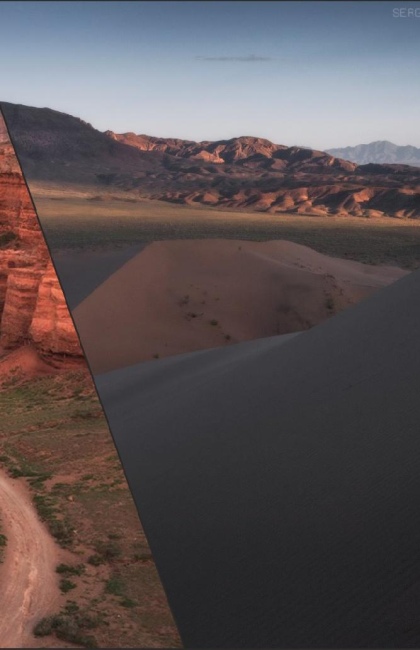Altyn-Emel National Park
Altyn-Emel National Park is a protected area located in the southeastern part of Kazakhstan. Established in 1996, the park is named after the Turkic-Mongolian phrase «Golden Saddle», which refers to its location in the middle of the Ili intermountain basin. Altyn-Emel is one of the largest protected areas in Kazakhstan, covering an area of more than 300,000 hectares. Its northern boundary rests on the mountain ranges of the Dzungarian Alatau, while the southern border runs along the Ili River and the Kapchagai Reservoir.
Notable landmarks
Altyn-Emel National Park is a haven for ecological tourism and recreation, offering a cluster of objects of amazing beauty and unique significance. From the stunning Singing Dune to the Saka burial mounds of Besshatyr, every corner of the park holds something rare or completely unique. Visitors can explore the Aktau and Katutau Mountains, the Tamgaly-Tas Petroglyph Site, the Oshaktas Stelae, the Mynbulak Tract, and the Ungirkora Cave. Altyn-Emel springs are also famous for their healing waters, including Chokan Valikhanov spring, Kosbastau spring, and Naizatapkan spring.
The Singing Dune is one of the most popular attractions in Altyn-Emel. It is a natural phenomenon created by sand accumulation in the valley of the Ili River. The dune is over 150 meters (492 ft) high and more than 3 kilometers (1.9 mi) long. It is called the Singing Dune because the sand produces a low-frequency sound when the wind blows, resembling the sound of a distant airplane or the singing of whales.
The Aktau and Katutau Mountains are another must-visit destination in Altyn-Emel National Park. The Aktau Mountains are famous for their unique landscapes, formed by multicolored layers of sedimentary rocks that are more than 400 million years old. The Katutau Mountains, on the other hand, are made up of volcanic rocks and offer stunning views of the surrounding landscape.
Burial Mounds of Besshatyr are ancient Scythian burial grounds dating back to the 4th-3rd centuries BC. They are located in the middle of the Tamdytau-Karatau mountain range and are considered one of the most significant archaeological sites in Central Asia. The Tamgaly-Tas Petroglyph Site is also an important archaeological site, featuring more than 5,000 rock carvings dating back to the Bronze Age. These petroglyphs are not to be confused with the petroglyphs of the same name, located northwest of Almaty).
The Oshaktas Stelae date back to the early Iron Age. This prehistoric monument is located near the village of Bakanas in Altyn-Emel National Park and is considered one of the most important monuments of the Saka period.
The Ungirkora Cave is the largest cave discovered in Altyn-Emel National Park. Its height is 20 meters (66 ft), and its depth is 25 meters (82 ft). According to researchers, the cave served as a dwelling for ancient people, as evidenced by its structure and the remains of ancient animals found inside.
The Mynbulak Tract is a great place to relax in the park under the branches of a sprawling tree. It is here that the migratory routes of such animals as gazelles, argali, and kulans pass. They head towards water bodies during the dry season. Most often, the movement of these rare animals can be observed in the morning or evening hours.
Altyn-Emel National Park is not only a place of natural wonders and archaeological sites but also an incredibly rich flora and fauna. Visitors can encounter various animals, including the Siberian ibex, the red deer, the lynx, the goitered gazelle, and the Przewalski's horse. Read more about the park’s wildlife in this article.
Climate
Altyn-Emel is a region with a sharply continental climate. The park's summer temperatures range from 29-32ºC (84-90ºF), while winter temperatures can drop to -3 to -8ºC (27-18ºF). The region is known for frequent winds and clean air, thanks to the absence of industrial facilities in the area.
Altyn-Emel & UNESCO
Altyn-Emel has been recognized by UNESCO as a World Biosphere Reserve as part of the «Man and the Biosphere» program. With its diverse ecosystem, rich cultural heritage, and abundance of historical monuments, the park is a valuable asset that requires preservation for future generations.
Visitors to Altyn-Emel are reminded that it is a «specially protected area» and that an eco-fee applies. Visitors must not damage the environment or pollute water sources, feed or scare animals, light fires or camp in unauthorized areas, or engage in activities such as fishing, hunting, and tree felling. Visitors are also not allowed to damage historical objects, take artifacts, or litter.
Where to stay?
Basshi village offers comfortable hotels and guesthouses that are popular among tourists. Visitors can also stay at the park's cordons, including Shygan, Taigak, and Zhantogai.
How to get there?
To get to Altyn-Emel, visitors can take the Almaty-Ust-Kamenogorsk or Almaty-Khorgos highways to the P-20 highway, which passes through the town of Konayev and the Kapchagai Reservoir. Trains run to Konayev from the Almaty-1 railway station, but visitors will need an SUV to access the park's attractions.
Our tours of Altyn-Emel are available for visitors who want to experience the park's beauty and diversity. Experienced guides lead the tours, which can last between 2-4 days. Visitors are picked up from their hotels or homes in Almaty and taken to the park in comfortable cars. Despite our attempts to describe the park's beauty, it is impossible to do it justice. Therefore, we invite visitors to take advantage of our tours to experience the breathtaking Altyn-Emel Park.

_420x650_4ab.jpg)
_420x650_4ab.jpg)

_420x650_4ab.jpg)